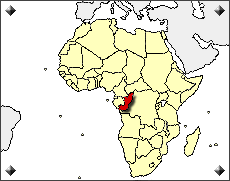
Larger-scale societies emerged between 1000-1500 A.D. and were based on villages composed of clans with ruling chiefs. During this period, the ruler of the Kongo empire was Manikongo with his capital city in Mbanza. The Kongo flourished under the reign of Manikongo as a highly developed state dealing primarily with trading; the empire traded natrual resources, ivory, and manufactured goods such as pottery, copperware, and cloth.
In the coming decades, the Kongo changed the strategy of the trade industry by becoming exporters of human cargo to European countries, namely Portugal. However, in 1526 the slave trade began taking its toll on the Kongo when the Portuguese sought to thwart the authority of Manikongo in order to secure control of the slave trade. Emperor Manikongo wrote the King of Portugal to stop the practice of the slave trade;but, his antics went unanswered and the coalition between the Kongo and Portugal was severed. The Kongo by a loss of manpower was devitalzed and fell prey to the Portuguese. The Portuguese saw this as a prime opportunity to increase the number of slaves being taken from the region. Under increasing pressure of wars with other states and the gradual decline of the population which brought about the decline of the Kongo empire in the 18th century.
